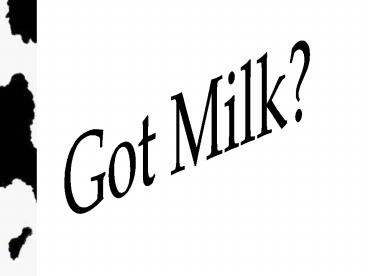Dairy Cattle - PowerPoint PPT Presentation
1 / 28
Title:
Dairy Cattle
Description:
Guernsey. Brown Swiss. One of the oldest Dairy breeds. Above average milkfat content ... Guernsey 4.57 611 13,363 'Milk Shake' Facts About Dairy Cattle ... – PowerPoint PPT presentation
Number of Views:1703
Avg rating:3.0/5.0
Title: Dairy Cattle
1
(No Transcript)
2
Dairy Cattle
3
Dairy Cattle
- Lactation - span of time that a cow is giving
milk - Dry Cow- A cow that is between lactations
4
Dairy Cattle
- Mammary system - parts of the cow directly
responsible for producing and storing milk
5
(No Transcript)
6
Breed Identification
- Dairy Cattle
7
Holstein
- Known for their black and white markings
- 90 of the dairy cattle in the U.S are Holstein
- Heavy milk producers
8
Jersey
- Color varies (light gray to a dark fawn being
darker around the head and hips)
9
Jersey
10
Jersey
11
Guernsey
- Red (Fawn) and White in color
- High milk production to feed intake ratio
12
Guernsey
13
Brown Swiss
- One of the oldest Dairy breeds
- Above average milkfat content
14
Brown Swiss
15
Ayrshire
- Red and white in color (amount varies)
- Average milk production
16
Ayrshire
17
Milk Production Facts
Breed Percent Butterfat Pounds B
utterfat Pounds Milk Holstein 3.
66 703 19,185 Ayrshire 3.95
569 14,398 Jersey 4.75 6
18 13,020 Brown Swiss 4.03
606 15,062 Guernsey 4.57 61
1 13,363
18
Milk Shake
19
Facts About Dairy Cattle
- It takes 500 gallons of blood to pass through the
udder to make 1 gallon of milk! - To make 9 gallons of milk a day, a cow must drink
18 gallons of fresh, clean water (2 gallons of
water for every gallon of milk). - The average cow produces 90 glasses of milk a
day.
20
More Facts
- Milk leaves the cow at 101 degrees Fahrenheit and
is promptly cooled and stored at 40 degrees
Fahrenheit. - It takes 10 pounds of milk to make 1 pound of
cheese.
21
The Farm
The cows are placed in the holding pen while they
are waiting to be milked.
22
The Farm
Workers view of the parlor
Cows view of the parlor
Next, the cows are placed in the milking parlor.
This is where the actual milking takes place.
23
The Farm
Milking unit
The cows are lined up one behind the other at an
angle so that the utters are facing the milking
units
24
The Farm
Cows teat (1 of 4)
The teats have been sprayed with teat dip in
order to clean them before milking and will be
wiped off with a clean paper towel before the
milker is placed on the teats.
25
The Farm
After the teats are cleaned the milking unit is
then placed on the cow. The average milking time
for a cow is five minutes.
26
The Farm
Automatic wash system- runs sanitation wash
through all pipes and milking units to sanitize
after each milking.
Pulsator- provides suction for the milking units.
Main control to the milking system.
27
The Farm
The milk from the cows will finally end up in the
bulk tank. When the milk truck driver arrives it
is his responsibility to take samples of the milk
from the bulk tank.
28
The End
- Moo































